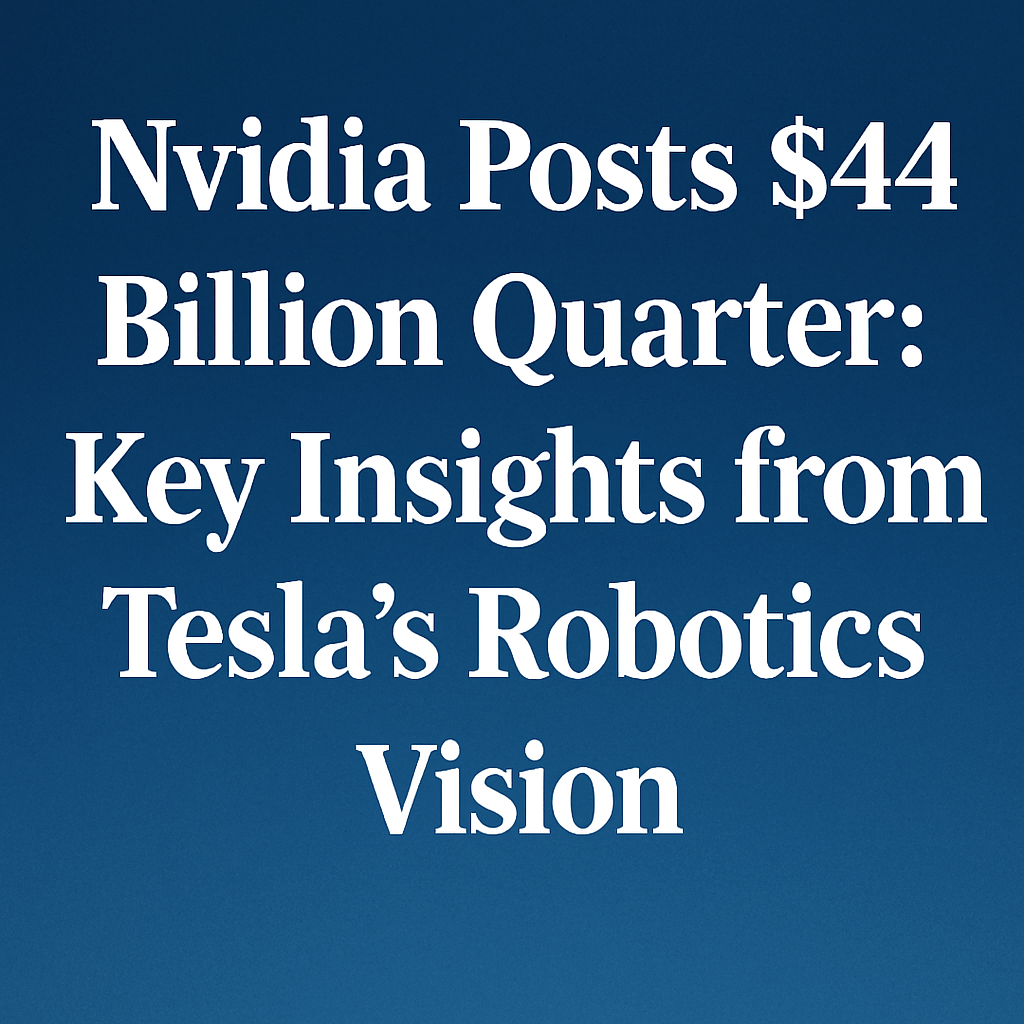Nvidia Posts $44 Billion Quarter: Key Insights from Tesla’s Robotics Vision

Nvidia has made headlines once again with its remarkable quarterly earnings report, announcing a whopping $44 billion in revenue, representing a staggering 69% increase compared to the same period last year. This impressive figure is almost enough to buy General Motors outright, highlighting Nvidia’s dominant position in the technology sector.
Exceptional Performance Across Segments
The data center segment has emerged as a powerhouse for Nvidia, bringing in $39 billion alone, showcasing the ongoing demand for high-performance computing, particularly in AI applications. Despite facing U.S. export restrictions which have impacted sales to China, Nvidia still managed to post an impressive profit of $18.8 billion this past quarter.
Insights from CEO Jensen Huang
However, the most pivotal revelations during Nvidia’s earnings call didn’t stem solely from its financial performance but from insights shared by CEO Jensen Huang regarding Tesla’s ambitious humanoid robot project, known as Optimus. Huang expressed keen interest in this initiative, stating,
“This is the first robot that really has a chance to achieve the high volume and technology scale necessary to advance technology.”
Huang’s enthusiasm isn’t unfounded. His forecasts suggest that the humanoid robotics market may be on the verge of a major evolution, positing that this could spiral into a multi-trillion dollar industry. This statement bears weight given Huang’s strategic role in driving the AI boom, particularly as Nvidia chips are integrated into major corporate frameworks.
The Broader AI Landscape
Nvidia’s GPUs are the backbone of many advanced AI applications, with companies like Microsoft—holding a significant stake in OpenAI—actively purchasing Nvidia chips to support their AI initiatives. Recent figures reveal that Nvidia processed over 100 trillion AI tokens last quarter alone, a testament to the chipmaker’s essential position in the technological ecosystem.
Despite the rise of competitors, such as Google, Meta, and Amazon, which are developing their own custom AI hardware, Nvidia continues to be indispensable. The company’s vast influence gives Huang a unique vantage point, allowing him to identify emerging trends and opportunity areas effectively, such as its investments in Applied Digital Corp (NASDAQ: APLD) for data center solutions and shares in Arm Holdings (NASDAQ: ARM) for semiconductor design.
Tesla’s Ambitious Robotics Vision
Elon Musk’s perspective on the Optimus project outlines not only the technological advances but also the short- and long-term production targets. Based out of Tesla’s Fremont facility, the goal is to manufacture thousands of Optimus units for deployment in Tesla’s factories by the end of next year, emphasizing efficiency gains through automation. Musk has larger ambitions, aiming to produce a million Optimus units annually by 2030.
Currently, the Optimus robot is capable of basic tasks—walking, stacking boxes, and performing simple functions—but still faces challenges regarding mobility and fluidity of movement. The technology may resemble early versions of groundbreaking devices that eventually reshaped entire industries, similar to how the initial iterations of the iPhone evolved.
Market Potential of Humanoid Robotics
The potential market impact of humanoid robots is significant, with investors keeping a watchful eye on predicted growth figures. Analysts at Goldman Sachs anticipate this market could reach as much as $38 billion by 2035, while Morgan Stanley offers a larger estimate, forecasting a market worth up to $4.7 trillion annually by 2050. These projections underline the transformative nature of humanoid robotics across various sectors.
Transforming Workforce and Industries
Optimism surrounds the impact of humanoid robotics on various industries, including:
- Logistics: Automated tasks could optimize warehousing and delivery processes.
- Elder Care: Robots could provide assistance and companionship to the aging population.
- Retail: Enhancing customer service through robotic sales associates.
- Hospitality: Streamlining operations in hotels and restaurants.
- Personal Companionship: Home robots that adapt to various personal needs.
The potential for disruption in these areas is massive, hinting at economic shifts that could ally with technological innovation.
The Road Ahead for AI and Robotics
Jensen Huang’s leadership at Nvidia has fostered pivotal technological advancements, and his insights into humanoid robotics echo the patterns seen in previous tech revolutions. The complex relationship between AI and robotics could lay the groundwork for entirely new sectors driven by transformative intelligence.
As Optimus robots learn through interaction, they generate invaluable data, serving as a sensory interface between machine learning and real-world experiences. This process of continual learning could bridge the gap towards artificial superintelligence (ASI) by enhancing data input quality and breadth.
Nvidia and Tesla are now at the crossroads of technological evolution, and the synergy between their initiatives may very well catalyze the next massive leap in AI and robotics, warranting attention from investors and technologists alike.
Conclusion
While opinions about Jensen Huang may vary, his predictions deserve consideration based on Nvidia’s history of innovation and market insight. Tesla’s Optimus project, positioned alongside Nvidia’s technological capabilities, suggests a future where labor is augmented by advanced humanoid robots—potentially revolutionizing how industries operate.
Investors should closely monitor developments in this area, as the implications stretch far beyond Nvidia and Tesla, ultimately influencing the fabric of economic activity across the globe.
Regards,
Ian King
Chief Strategist,
Banyan Hill Publishing
Have Your Say
We encourage your feedback! Share your thoughts or suggestions for our next newsletter by emailing dailydisruptor@banyanhill.com.
Your insights are invaluable to us, and we ensure anonymity in any published responses.